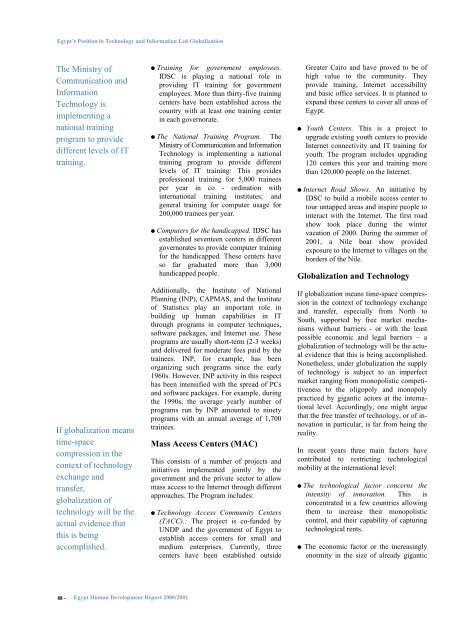English - Human Development Reports - United Nations ...
English - Human Development Reports - United Nations ...
English - Human Development Reports - United Nations ...
Create successful ePaper yourself
Turn your PDF publications into a flip-book with our unique Google optimized e-Paper software.
Egypt’s Position in Technology and Information Led GlobalizationThe Ministry ofCommunication andInformationTechnology isimplementing anational trainingprogram to providedifferent levels of ITtraining.If globalization meanstime-spacecompression in thecontext of technologyexchange andtransfer,globalization oftechnology will be theactual evidence thatthis is beingaccomplished.● Training for government employees.IDSC is playing a national role inproviding IT training for governmentemployees. More than thirty-five trainingcenters have been established across thecountry with at least one training centerin each governorate.● The National Training Program. TheMinistry of Communication and InformationTechnology is implementing a nationaltraining program to provide differentlevels of IT training: This providesprofessional training for 5,000 traineesper year in co - ordination withinternational training institutes; andgeneral training for computer usage for200,000 trainees per year.● Computers for the handicapped. IDSC hasestablished seventeen centers in differentgovernorates to provide computer trainingfor the handicapped. These centers haveso far graduated more than 3,000handicapped people.Additionally, the Institute of NationalPlanning (INP), CAPMAS, and the Instituteof Statistics play an important role inbuilding up human capabilities in ITthrough programs in computer techniques,software packages, and Internet use. Theseprograms are usually short-term (2-3 weeks)and delivered for moderate fees paid by thetrainees. INP, for example, has beenorganizing such programs since the early1960s. However, INP activity in this respecthas been intensified with the spread of PCsand software packages. For example, duringthe 1990s, the average yearly number ofprograms run by INP amounted to ninetyprograms with an annual average of 1,700trainees.Mass Access Centers (MAC)This consists of a number of projects andinitiatives implemented jointly by thegovernment and the private sector to allowmass access to the Internet through differentapproaches. The Program includes:● Technology Access Community Centers(TACC).: The project is co-funded byUNDP and the government of Egypt toestablish access centers for small andmedium enterprises. Currently, threecenters have been established outsideGreater Cairo and have proved to be ofhigh value to the community. Theyprovide training, Internet accessibilityand basic office services. It is planned toexpand these centers to cover all areas ofEgypt.● Youth Centers. This is a project toupgrade existing youth centers to provideInternet connectivity and IT training foryouth. The program includes upgrading120 centers this year and training morethan 120,000 people on the Internet.● Internet Road Shows. An initiative byIDSC to build a mobile access center totour untapped areas and inspire people tointeract with the Internet. The first roadshow took place during the wintervacation of 2000. During the summer of2001, a Nile boat show providedexposure to the Internet to villages on theborders of the Nile.Globalization and TechnologyIf globalization means time-space compressionin the context of technology exchangeand transfer, especially from North toSouth, supported by free market mechanismswithout barriers - or with the leastpossible economic and legal barriers – aglobalization of technology will be the actualevidence that this is being accomplished.Nonetheless, under globalization the supplyof technology is subject to an imperfectmarket ranging from monopolistic competitivenessto the oligopoly and monopolypracticed by gigantic actors at the internationallevel. Accordingly, one might arguethat the free transfer of technology, or of innovationin particular, is far from being thereality.In recent years three main factors havecontributed to restricting technologicalmobility at the international level:● The technological factor concerns theintensity of innovation. This isconcentrated in a few countries allowingthem to increase their monopolisticcontrol, and their capability of capturingtechnological rents.● The economic factor or the increasinglyenormity in the size of already gigantic88 -Egypt <strong>Human</strong> <strong>Development</strong> Report 2000/2001
















